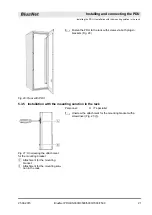
1.2 Short description
The power supply of a data centre can be monitored and controlled
remotely via the PDU. The PDU can be set up for single-phase or
three-phase systems. The individual phases can be distinguished
by their colours. The PDU is supplied with electricity via a CEE
plug.
The current, power (active, apparent and reactive power), power
consumption, voltage and frequency of all phases are monitored
via the PDU. This enables the efficient planning of resources and
the issuing of an alarm in the event of a fault. The PDU is designed
for a power range of 3.6 to 22 kW.
The PDU is integrated into the company network via the LAN port
(only available on the master PDU). Up to 10 slave PDUs can be
cascaded with a master PDU via the Modbus port.
The PDU can be operated locally via the display, via SNMP access
or with a web browser over a network, and the HTTP, HTTPS,
SSH, SNMP and Modbus-TCP protocols can be used.
The PDU is made of a sturdy aluminium profile and is installed
directly into the rack.
Depending on the type, the PDU has a variety of features such as
safety-plug sockets or IEC320 C14 and C20 type non-heating
appliance connectors, and external sensors (temperature/
humidity).
A connector inserted into the PDU can be secured with the non-
heating appliance locking device (C13/C19).
1.3 Displays and controls
The PDU can be operated locally via the display using the control
keys:
n
Display system data (hardware and software version,
serial number, MAC address and item no.)
n
Display the measured data
n
Set the duration and orientation of the display
n
Display and adjust the network settings as well as enabling or
disabling the DHCP protocol
Display with control keys
Fig. 7: Display with control keys
Overview
Displays and controls
25.09.2015
BlueNet PDU BN3000/3500/5000/7000/7500
8









































